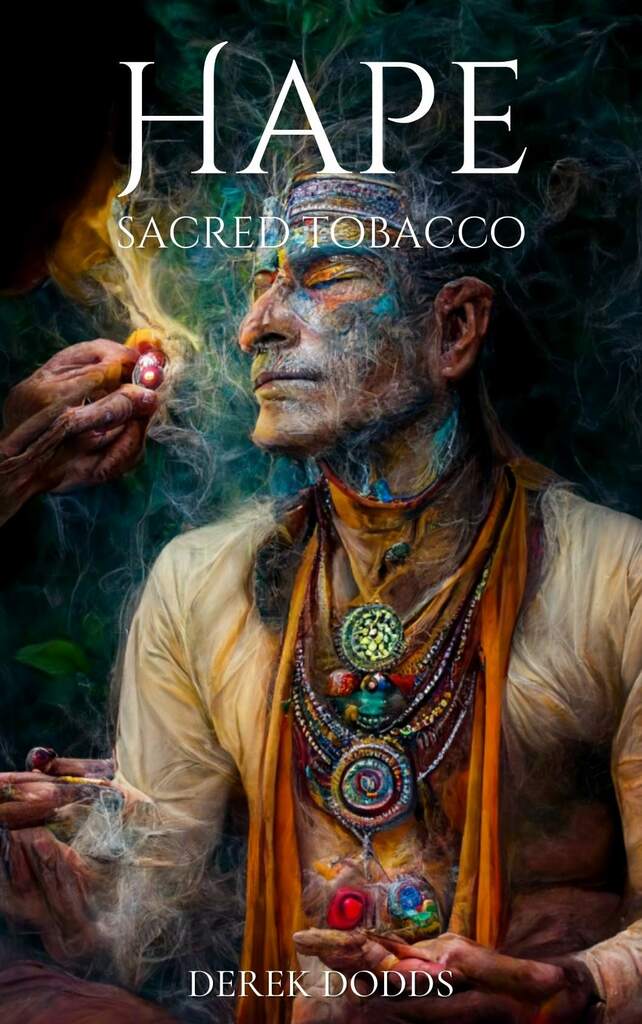What is Hape (or Rapé)? The Sacred Tobacco Plant of the Amazon
Introduction to Hape
What is Hape? Hape (pronounced ha-pe), also known as hapeh or rapé, is a sacred tobacco plant used by indigenous healers in the Amazon rainforest for thousands of years—also known as Hape medicine. In recent years, it has gained popularity among Westerners as a powerful shamanic medicine for healing and spiritual purposes. In this blog post, we will explore the history, preparation, effects, and cultural significance of Hape ceremony.
“Lamista Quechua shamans frequently assert that tobacco is the ‘father of all plants,’ a male consort to the ‘mother spirits’ of all shamanic plants.”
~ Jeremy Narby, Plant Teachers: Ayahuasca, Tobacco, and the Pursuit of Knowledge
Table of contents
History of Sacred Tabacco
The use of tobacco as a sacred plant dates back to ancient times. In the Amazon rainforest, Hape medicine (Hape ceremony) has been used by indigenous groups such as the Yawanawa, Noke Koi, and Huni Kuin for spiritual and medicinal purposes. Hapé connects us to the spirit world and can be used to heal physical, emotional, and spiritual ailments.
Hapeh decalcifies the third eye and scans the body for blockages and energetic misalignment. I have found it beneficial for opening my heart, grounding, and creating clarity—it softens my ego and allows me to listen to my higher self.
Preparation of Rapé
Preparing Hape medicine is a complex and sacred process involving many steps. First, the tobacco leaves are harvested and sun-dried. Then, they are ground into a fine powder and mixed with other ingredients, such as ashes from sacred trees, herbs, and spices [2].
The ingredients and proportions of the mixture can vary depending on the healer and the intention of the ceremony. Sacred plants carry the energy of those that prepare them; thus, where you buy hape is very important (I recommend trusted vendors at the end of the article).

Effects of Sacred Tobacco
When Hape tobacco is administered, it is blown up the nostrils using a bamboo, wood, or bone pipe called a kuripe. The effects of Hape can vary depending on the individual and the dosage, but they usually include a sense of grounding, clarity, and heightened awareness.
Many people feel a solid connection to the earth and their inner wisdom. Hape is also known to purify and cleanse properties and can be used to clear the sinuses and lungs. The strongest feeling comes on about three minutes after application.
Application of Hape Medicine: Tepi & Kuripe
Hape medicine is administered with a tepi (pipe for when someone serves you Hape medicine) or kuripe (self-administrator pipe), a small pipe made of wood or bone. Bamboo is the most common material used to make Tepi because it is cheap, easy to handle, and can be quickly turned into a Rapé pipe. Tepis can also be made from bone or wood.

Kuripe Made of Bone
Selecting Your First Kuripe: Wood or Bone?
Picking the right kuripe is essential—we all have different noses and facial geometry. You need a kuripe that fits in your mouth (on the short end) and is long enough (on the long end) to administer the tobacco deep into your nasal cavity. If the kuripe is too short on either side, you will have difficulty blowing the sacred blend into your nostrils.
Your two main choices for a kuripe are bone or wood. I like to have one of each; the bone is more grounding, and the openings tend to be larger, which allows you to blow more Hape into your nose. This one from Four Visions is a good Bone Kuripe. The example below has a crystal at the bottom, which helps move the energy and acts as a vibrational asset for your Hape ceremony.

Bamboo is the principal wood used in most wood karipes. Each piece is unique and has its own handwoven design and a crystal point for grounding and protection to connect you to sacred hapé medicine. These bamboo Karipes come from the Yawanawa tribe, a powerful tribe that brings us lots of great Hape and tools directly from the forest. I like these Karipes because they have more extended application stems to get your Hape deep into the nose.

Being Served Hape: Tepi Application
A tepi (buy one here) is used when someone serves you Hape tobacco. You must know and trust the person serving Hape, who must have been appropriately trained—ideally by someone from the Amazon. There is a deep energy exchange during the process, and if the person blows too hard, you may damage your sinuses.
Receiving Hape in Amazon with Tepi : Hape Ceremony
Receiving Hape requires a relaxed yet mindful approach. Sit comfortably with your spine straight and your heart open. Relax your face and block your throat with a quick inhalation. As you receive, open your mouth to relieve the pressure from your ears. Set an intention or make a prayer and look the person serving you in the eyes.
Your chakras may be activated during your session, so it is highly recommended that you sit with your spine erect and open so that the energy may flow from your root to your crown. If desired, close your eyes during administration to prevent the powder from getting into your eyes. However, I like to look into the eyes of the person serving me to form a sacred connection.
Effects of Hapé
The use of Hapé can lead to various side effects, although they may vary from person to person and depend on the specific blend of ingredients. Here are some potential side effects associated with using Hapé:
Physical Effects
- Sneezing: The administration of Hapé through the nose can trigger sneezing in some individuals.
- Increased Salivation: Some people may experience increased salivation after using Hapé.
- Nausea: Nausea is a possible side effect and may result in vomiting.
- Eye Irritation: Hapé can cause temporary eye irritation or watering because the fine powder is blown into the nostrils.
Psychological Effects
Disorientation: Hapé may induce a sense of disorientation, altered mental states, or intense emotions. Some individuals may experience trauma release or changes in mood.
Physical Sensations
Dizziness: A feeling of dizziness or light-headedness can occur, mainly if one is not accustomed to the effects of Hapé.
Purging: In some traditional practices, purging is considered a cleansing process. This can involve vomiting, diarrhea, or other forms of physical release.
It’s important to note that these side effects are not universal, and many people use Hapé without experiencing them. The effects of Hapé can be influenced by the specific blend of ingredients, the dosage, and the individual’s sensitivity. Additionally, some indigenous cultures view particular side effects, such as purging, as part of ritual purification and cleansing.
Hape & Pineal Gland Activation
Tobacco, the hallucinogen? It’s not your typical mind-altering substance, but it contains two sneaky alkaloids, harman and norharman, distant cousins of the psychedelic duo harmine and harmaline. These two mischievous beta-carbolines decide to play with your brain’s chemistry by inhibiting monoamine oxidase. The result? It is an anti-depressive and stimulating rollercoaster, just like a carnival for your mind.
Packed with nicotine, it’s your golden ticket to enhanced brain blood flow and a party of stimulatory neurotransmitters, including epinephrine, acetylcholine, and dopamine. Your brain becomes the epicenter of focus, presence, and intuition—like Einstein meets the Dalai Lama.
Magnetic resonance imaging (MRI) shows the degree of calcium phosphate in the pineal gland, which can be tested for calcification. Aging has been associated with pineal gland calcification and decreased melatonin production. Our polluted water, which is often filled with hormones and residues of pesticides, as well as food additives, excess sugar, and sweeteners, can lead to calcification of the pineal gland.
Hape medicine whispers about decalcifying the pineal gland and thus boosting melatonin production. This tiny gland controls your circadian rhythm, melatonin, and immune system. While science hasn’t given it a standing ovation yet, it’s a hot topic. Pineal gland calcification is no joke; it’s linked to degenerative diseases, stroke, bleeding, and even breast cancer.
Melatonin, the superstar hormone, gets a natural boost during decalcification. Melatonin is a brain enhancer, immune guardian, and circadian rhythm conductor. Hape medicine might just be the sidekick we’ve been waiting for, potentially saving the day in diseases like Parkinson’s.
So, there you have it, the mind-bending journey into the world of tobacco and Hapé, where science meets mysticism, and the quest for pineal enlightenment continues.

Left vs Right Nostril Administration
Start with your left nostril, which is meant to clear any negativity or energetic blocks. Next, blow into your right nostril to help open your heart and creativity. Learning to administer Hape tobacco from an experienced practitioner before using it is recommended. It is vital to approach Hapé respectfully and understand its cultural and spiritual significance.
Hape Ceremony & Celebration
Hapé allows a connection to spirit and helps us tap into our inner strength and sensitivity while softening our egos. Rapé is a celebration of life facilitated by sacred plant medicine, allowing us to unite with great spirit. I treat it as a ceremony of the heart and dedicate my sessions to healing, prayer, and connection. I wish you a beautiful exploration of this powerful medicine.
Hape Ceremony: Set & Setting
Imagine stepping into the mystical realm of Hapé, where every plant is revered as a sacred messenger, a prayer to the universe. It’s like embarking on a cosmic journey with nature as your guide, and trust me, it’s a trip worth taking.
To truly honor this sacred medicine, create an ambiance fit for a sacred adventure. Prepare the space as you see fit: incense swirling, crystals shimmering, tribal rhythms filling the air, or Pacha Mama herself as your backdrop. Set your stage for a meditative and introspective Hapé experience.
But before diving in, you must set the stage within yourself. Find a moment of silence, a canvas for your intention. It could be a quest for wisdom, a longing for physical or energetic healing, or a search for clarity amidst life’s chaos. Once you’ve honed in on your intention, send it out into the universe or whisper it to the spirit world, asking for their guidance.

Making Hape in Amazon
Now, the Hape cememony begins. Inhale deeply and hold your breath, like a sacred pause in the cosmic dance. Hapé enters your left nostril, a nod to the cycle of life and death. Then, it travels to the right nostril, symbolizing rebirth, a cosmic do-over.
Inhale and exhale gently through your mouth, grounding yourself in the here and now. Resist the urge to verbalize the ineffable experience; instead, focus on the thoughts and energies swirling within. Avoid drama and suffering—harness the power of the knowledge, channel it to your heart, and feel the warrior’s strength and grounding wash over you like a cosmic reset button.
So there you have it, Hapé as your cosmic compass, guiding you through realms of intention, healing, and rebirth. It’s a journey for the adventurous soul!
Hape Medicine Ceremony: Setting Your Intention
Your mind, like a lush garden, thrives when tended to with care, love, and dedication. To make it bloom, wield the tools of positive affirmations, self-reflection, and unwavering focus. Nurture your mental garden daily, and you’ll witness its incredible growth.
You are your own shaman. Shamanism is a world filled with a diverse array of tools for healing Hape ceremonies and sacred rituals—feathers, drums, sticks, tobacco, chanting, and more. The purpose behind these tools is beautifully simple: imbue them with your intention, transforming them into vessels of amplified healing and manifestation.
Imagine lighting incense, reciting a prayer or mantra, channeling your intention, or taking Hapé as a creative act of embracing the present moment. These actions are your homage to the here and now, a profound acknowledgment of the plant’s wisdom and your spirit’s journey. They are your compass for achieving your goals, guiding you with reverence and dedication.
Shamanism (remember, that’s you) is the art of embracing intention and weaving it into the fabric of existence, a dance of the soul and spirit.
Buy Hape From a Trusted Source
Please don’t buy Hapeh from just anyone. You want to know how the tobacco is sourced, and it helps to know which tribes the Hape tobacco comes from. I made Hape this year on my visit to the Amazon (read about it here), and I was impressed by the prayers and songs invoked during the preparation.
Here is a list of vendors I recommend to buy rapé. I have bought Hape medicine from each of the vendors listed here. I personally vouch for the quality and authenticity:
- Four Visions This is my go-to source on the internet.
- The Mint is my favorite Hape from Four Visions; it is strong and leaves a refreshing feeling in the nostrils.
- I like the Tsuni. The purest blend available if you like it strong.
- To connect with the feminine, try Feminine Forca.
- Universe of Grace: A recent find, excellent blends, and a strength rating on each listing that helps you select the right blend.
- Durga blend is their strongest, rating 5 out of 5.
- Grandmother Ayahuasca is also rated 5 out of 5.
- Tribal Detox (fascinating blends and hard-to-find Hape)
- Katukina (in the Netherlands, high quality and authentic in Europe)
If you’d like to explore sacred tobacco in-depth, I recommend reading Plant Teachers: Ayahuasca, Tobacco, and the Pursuit of Knowledge by Jeremy Narby.
I also created a SoundCloud music playlist to inspire your Hapé journey.
Haux. Haux.
P.S. Sometimes, with extended Hape tobacco use, your sinuses can get clogged. It’s crucial to maintain a healthy and clean sinus cavity. See the following video for tips on clearing and cleaning your sinuses before your next Hape ceremony.











0 Comment